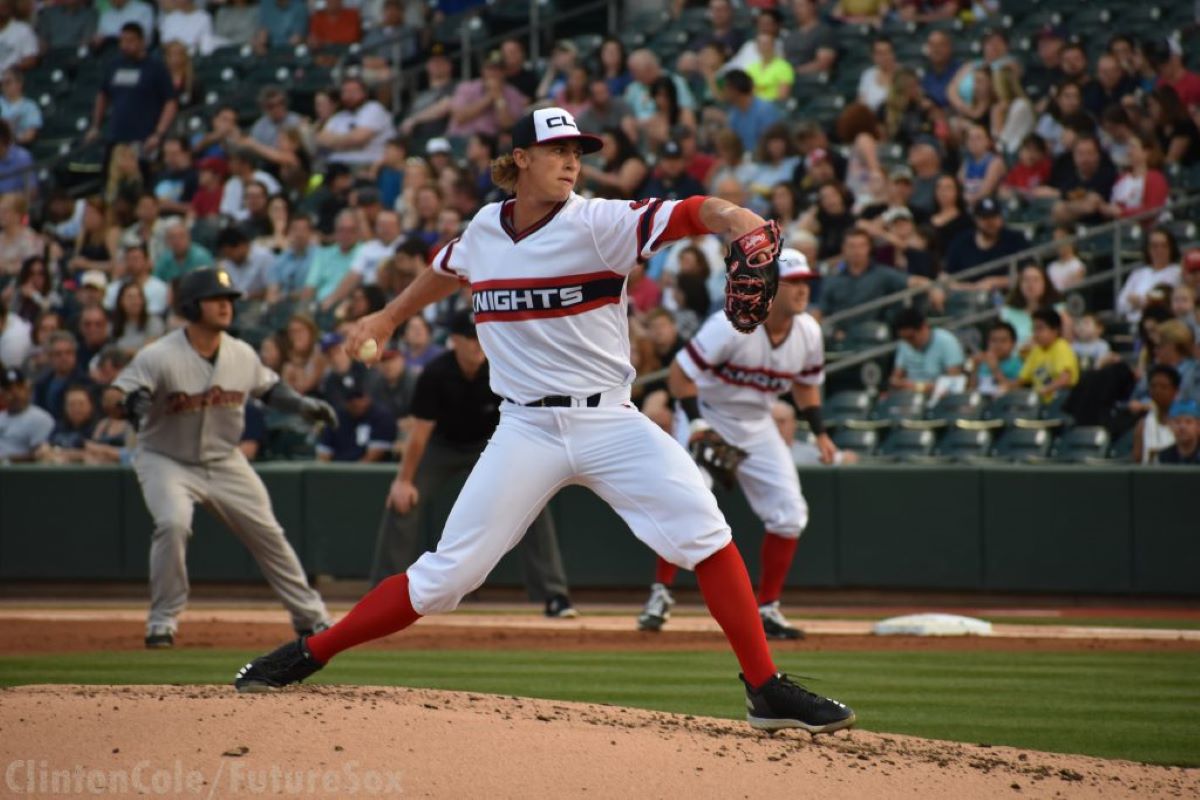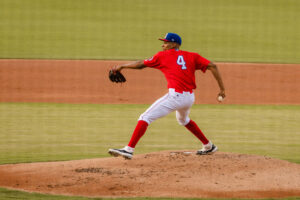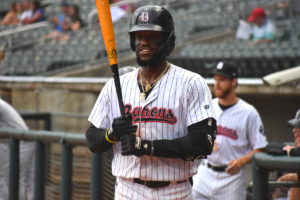Top White Sox Prospects by Position: Starting Pitchers

via Clinton Cole
The Chicago White Sox have done well to improve the depth of their starting pitchers thanks in large part to recent MLB Drafts.
With our 2021 preseason top 30 rankings on the horizon, we are gearing with a position-by-position breakdown of White Sox prospects. Here’s a look at the top ten starting pitchers in the White Sox organization today:
1. Michael Kopech
- FutureSox Top 30 Ranking: No. 3
- Last level: MLB (2018)
Turning 25 years old in April, Kopech still remains a prospect as a result of pitching in fewer than 50 MLB innings as well as spending fewer than 45 days on an active roster. Kopech last pitched in a competitive setting on March 10, 2020. That day six of his 11 pitches hit 100 mph in a Spring Training contest. It was his first outing since Sept. 5, 2018, and nearly 20 months after his Tommy John surgery.
Kopech sat out the 2020 MLB season, which saved the White Sox a year of contractual control. The right-hander will be arbitration eligible beginning in 2023 and is on pace to hit free agency in 2026. Kopech is slotted as the No. 39 overall prospect, according to MLB Pipeline.
The jury is still out on whether the Sox prefer to start him in the big leagues immediately following Spring Training. With the top three rotation spots filled by Lucas Giolito, Dallas Keuchel and Lance Lynn, Kopech has the value of a potential top-of-the-rotation arm while slotting in at the backend. The challenge ahead for Rick Hahn and company will be to determine Kopech’s innings limit after two and a half years away from the mound.
2. Garrett Crochet
- FutureSox Top 30 Ranking: No. 5
- Last level: MLB (2020)
Crochet was the first pitcher since Mike Leake in 2010 to make his major league debut prior to pitching in the minors. Drafted No. 11 overall, the White Sox worked closely with Crochet in suburban Schaumburg during the 2020 campaign, which helped the 21-year-old to appear in six games out of the bullpen.
A scare in Oakland had Sox fans holding their breath after Crochet left Game 3 of the Wild Card round, but the left-hander was diagnosed with a flexor strain in his pitching arm.
“No issues there,” Rick Hahn said in October. “We expect him to continue to progress and feel fine in a matter of weeks and be without restrictions come spring. That was a little bit scary for all of us. All things considered, that was about as good of a result as we could’ve hoped for here.”
Chris Getz, newly promoted assistant to the general manager told reporters the White Sox “certainly have the intention of him being a starting pitcher for us at the major league level.” However, Getz added he sees the lefty to fill a bullpen role in 2021.
3. Jared Kelley
- FutureSox Top 30 Ranking: No. 6
- Last level: N/A
Kelley is an example of a player who benefited from the 2020 baseball cancellations. Fresh out of high school, the White Sox snagged the 6-foot-3, 215-pound right-hander in the second round and would likely not see a professional mound outside of monitored appearances in the Arizona League.
As it turned out, Kelley worked closely with Sox player development staffers in Schaumburg and had an opportunity to pitch to major league hitters.
“My very first hitter that I faced, pretty much my minor league debut hitter was Nicky Delmonico,” Kelley said. “It was tough. I threw some tough pitches and he didn’t even budge on them. So I’m like ‘I guess this is pro ball.’ Ended up walking him, but it was the first batter.”
4. Jonathan Stiever
- FutureSox Top 30 Ranking: No. 8
- Last level: MLB (2020)
Seldom do fans experience a pitcher make his major league debut with the highest level of pro ball being Single-A. That’s what happened with Stiever, who showed his unpolished, yet noticeably impressive repertoire in two big league starts.
Turning 24 years old in May, Stiever is expected to spend significant time in the minors this season. The fifth round pick will need to make command a priority in 2021, as Stiever features a true 12-6 curveball that ranges from 77-79 mph paired with a low-to-mid 90s fastball.
5. Matthew Thompson
- FutureSox Top 30 Ranking: No. 9
- Last level: AZL (2019)
Thompson was the first of three high school pitchers drafted in 2019 and 2020. While Jared Kelley projects to have the higher upside, Thompson is credited with having three plus pitches, which includes a fastball that can touch 97 mph.
The 20-year-old, according to Baseball America, is regarded as the best athlete in the White Sox system. Thompson added muscle to his 6-foot-3, 195 pound frame and has the making as a future major league starter. The right-hander projects to pitch in a full season affiliate, likely to start in Class-A Kannapolis, and will work on commanding his 60-grade fastball, 60-grade curveball and 50-grade changeup.
6. Andrew Dalquist
- FutureSox Top 30 Ranking: No. 10
- Last level: AZL (2019)
Dalquist is the final high school draftee on this list and he is arguably the most polished of the bunch. He slots in as the third best prospect of the group to no fault of his own. The upside attached to Thompson and Kelley is just that serious.
Highlighting Dalquist’s most encouraging attributes is his projectable frame and pitch mix. He improved his fastball in 2020 from low 90s to sitting at 94-95 mph consistently. He accompanies his fastball with a curveball, changeup and slider.
Dalquist turned 20 in November and features a repeatable, athletic delivery that allows him to consistently pound the strike zone. He, like Thompson, is also likely ticketed for Single-A Kannapolis to begin 2021.
7. Kade McClure
- FutureSox Top 30 Ranking: N/A
- Last level: A+ (2019)
McClure was left off our 2020 midseason top 30, but the soon-to-be 25-year-old is about to shoot up the White Sox prospect rankings. The tall righty dealt with a severe knee injury on his plant leg that ended his 2018 season. His development was slowed as a result, but responded well by tossing 121 innings in Kannapolis and Advanced-A Winston-Salem in 2019.
The past year offered McClure a reset of sorts. He worked closely with biomechanics specialist Ben Hansen to improve his velocity, which has translated to a low-to-mid 90s fastball. Sources have indicated to FutureSox that McClure turned the heads of scouts during instructs, resulting in minor interest from teams across the league prior to the Rule 5 Draft. The 6-foot-7, 230 pound sixth-round pick out of Louisville has a frame that screams power pitcher, although that doesn’t fit this particular description.
Across his professional career, McClure has allowed fewer than one hit per inning and holds a respectable 2.4 BB/9. Entering his fourth season in the Sox system, McClure will likely begin in Double-A Birmingham with a call to Charlotte not too far away.
8. Bernardo Flores
- FutureSox Top 30 Ranking: No. 27
- Last level: MLB (2020)
The White Sox had an opportunity to evaluate Bernardo Flores at the big league level in 2020. The left-hander does not offer overpowering stuff, but relies heavily on command. In fact, Flores may possess the best control of his pitch mix than any other pitching prospect in the White Sox’ system.
Flores offers four pitches including a 92 mph fastball, 74 mph curve, 84 mph slider and an 84 mph changeup. The 25-year-old provides depth to the Sox’ Triple-A rotation and has a chance to make spot starts at the major league level. His floor is a pen arm who specializes in long relief.
9. Konnor Pilkington
- FutureSox Top 30 Ranking: No. 21
- Last level: A+ (2019)
Pilkington remains on White Sox prospect lists because of his pitchability. Drafted in the third round of 2018, Pilkington works quickly on the bump and incorporates a deceptive looping curveball, which is considered his best offering.
Pilkington dominated in his first stint at Low-A Kannapolis, but leveled out in an improved Carolina League environment. Entering his age 23 season, Pilkington has a shot at beginning the year in Double-A Birmingham.
10. Bailey Horn
- FutureSox Top 30 Ranking: N/A
- Last level: N/A
Of the five draft picks taken by the White Sox in 2020, Horn was the lone player to receive a signing bonus equivalent to the value of his draft slot. Horn is advanced following his two seasons at Auburn.
The White Sox believe Horn can develop as a starter. His fastball sits in the low 90s with tail and offers a plus curveball while also experimenting with a loopy slider. Horn is also working to improve his changeup.
His athleticism gives him a leg up in developing as a future major league regular. The 6-foot-2, 210-pound 23-year-old lefty figures to begin his first full professional season in High-A Winston-Salem with an opportunity to quickly rise to Birmingham.
Not listed: Norge Vera
Top international prospect Yoelqui Cespedes officially signed with the White Sox on January 15. It’s been widely reported the organization has also landed international right-hander Norge Vera, although the signing has yet to be made official.
Special assistant to the general manager Marco Paddy told the media he was confident in the organization’s ability to get the deal done officially. Until the deal is official, we are keeping him off our lists.
Photo credit: Clinton Cole/FutureSox
Want to know right away when we publish a new article? Type your email address in the box on the right-side bar (or at the bottom on a mobile device) and click create subscription. Our list is completely spam free, and you can opt out at any time. Also, consider supporting FutureSox on Patreon! You can get early access to special articles and Patreon-only posts, in addition to more benefits.
Shop our exclusive merchandise! Show your support with FutureSox apparel.







I love the list, although I’d have been tempted to place Jimmy Lambert over Pilkington and Horn. Another name I’d like to see in 2021 would be Ronaldo Guzman. Overall, I’d have to say the Sox organization is far deeper with starters than any other position — with the possible exception of the bullpen. Anyway, keep up the great work!
I agree about Lambert. Wouldn’t he be the first starter called up if they needed one or is he relegated to relief now?